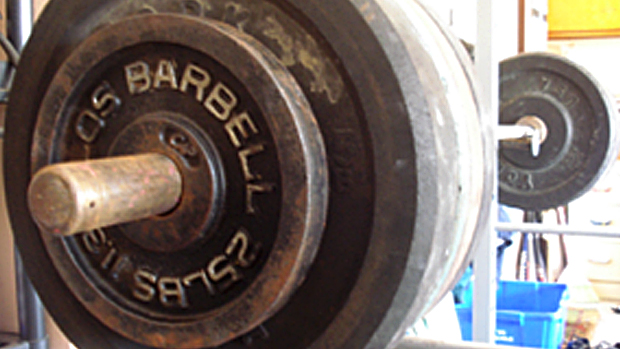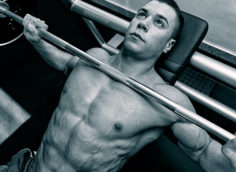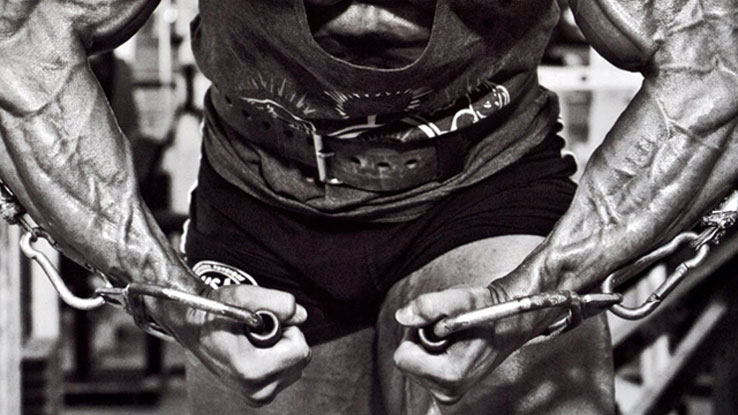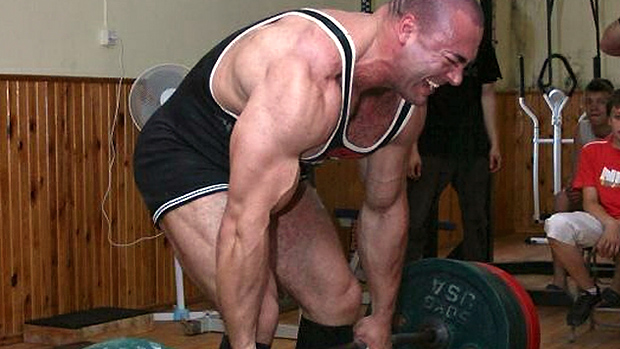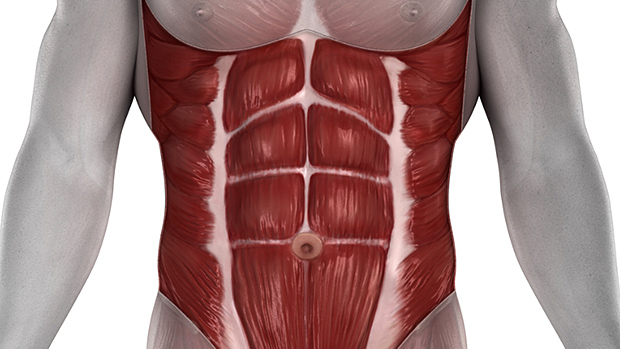Like many of you, I read all of the articles here at
Testosterone, and am always interested in the new ideas,
approaches, and research presented by the top-notch writers and
coaches who contribute to the site. It's always great to see what's
working for many of their clients, and tap into the trove of their
experience and knowledge.
But in my case, training is my obsession, not my
profession. So most of my "research" is personal experience, and my
only "clients" (or "victims," if you like) are me, my son, and my
powerlifting friends. Regardless, I do see a great number of
non-powerlifters in the numerous gyms I visit throughout the
country, and I think that these notes, which I've jotted down in my
training log after inspired conversations and observations, can
help you out in your training.
1. Be Like Mikey
Remember that great Life Cereal commercial a few decades ago? Two
boys are arguing over a new breakfast cereal, and neither of them
wants to be the first to try it. They slide it over to their little
brother Mikey, who "hates everything." Mikey, however, tries the
new cereal, and hey, he likes it!

Mikey can afford a few high-glycemic carbs on deadlift
day.
The point I'm making here is that you'll never know if
Bulgarian squats, WSB, German volume training, HIT, WS4SB, one lift
a day, max recruitment training, refined physique training, front
squats, board press, and any of the zillion nutrition and
supplement approaches work until you try them for yourself.
Sure, do your homework, and check out everything you can as
thoroughly as possible, but then you gotta get to work! If you
spend hours chatting with your buddies on internet bodybuilding
forums like a schoolgirl on Myspace, then go to the gym and do the
same old pyramid workout you've done since high school, you'll be
sitting on a plateau before long, if you're not there
already.
Folks always ask me about the "perfect" program. They should
remember what General Patton said: "A good plan violently executed
today, is better than a perfect plan next week." Old George would
also probably bark, "quit piddling around! Just pick a damn
program, and do it!" Just like Mikey, you might like it, and
if you don't, then you know that one doesn't work for
you.
2. Home is Where the Hard Is
For many years, I avoided having my own workout equipment at my
home. I enjoyed the camaraderie of gyms, and didn't like working
out alone. As the years passed, and family responsibilities
increased, my ability to get to the gym 4-10 times a week has
evaporated.
I thought that if I had a few weights and a glute ham raise, I
could add in the assistance I was almost always skipping, and add
in those extra rehab and prehab workouts I was missing because I
ran out of time in the gym. So over the past year I finally put
together a small hardcore gym in my garage. I don't have a monolift
out there (although my really hardcore training partner Jeff
-242elite does!), nor do I gear up out there all alone.
However, I can do deadlifts, chins, pull-ups, glute ham
raises, raw squats, box squats with bands, pin presses, and lighter
raw benches. I can drag my sled behind my house, or do a monster
arm workout (actually, I work my arms like I do my taxes: at the
last minute, and once a year). I can do kettlebell swings and
snatches, and I even picked up a reverse hyper that somebody was
giving away. I added gymnastic rings, which my kids love, and are
great for pushups, dips, and pull-ups.
I highly recommend considering some type of home gym option if
you can, but be warned: you might get more hardcore than you
intended. At home there's no conversation, no grab-assing, no eye
candy, and no juice bar. Just the raw, hard discipline of the iron
and your next set.
<!-- 
There are fewer distractions when you train at
home.
-->
You'll find that you end up doing mostly the hard lifts that
give you gains in your home gym, and not a whole lot of triceps
kickbacks and leg curls. Working out in your own home gym also
makes you confront what you're doing and why you do it. You might
find yourself dragging your sled at 10 at night, or doing a barbell
complex at 5 AM with the garage door open for ventilation before
you head to the airport for a trip.
These are workouts that force you to confront the reasons why
you train. You might come to the hard conclusion that you don't
want it that much. On the other hand, the confrontation might make
you reach that much farther inside yourself, and resolve to do
whatever it takes to achieve your goals. Let the neighbors call the
police all they want.
3. My Bench Shirt is Bigger Than Your Pec Deck and Cable
Crossover Combined
At the two gyms I train at the most, the patrons are mostly
military. The pec dec is long gone, and the cable crossover has a
pull-up bar over it, so it's used very rarely. If only this were so
at some of the other gyms I've seen. I see tons of guys wailing
away at the pec deck, and even more straining at the cable
crossover, grimacing in their little wife-beater tank tops,
imagining all the mass and separation they're gaining in their
chests.
The sad news is, they're doing neither. Unless you're over 200
pounds, pushing 50 inches in the chest, bench pressing over 315, or
have enough drugs coursing through you to get invited to a Jose
Canseco dinner party, you need to be doing more heavy barbell
benching and stay away from those machines.
Heavy weights and moderate volume are the baseline method of
hypertrophy, so leave the pec decks and cables to the genetic
freaks in the bodybuilding magazines. For example, if you can bench
315 raw, you might be able to hit 315 for 3-8 reps in a loose bench
shirt. This'll give you growth in your triceps, forearms, and chest
that you might not believe.
Conservatively, my loosest single ply shirt gives me 60-70
pounds carryover. Imagine repping out 50 or more pounds than you do
now. Think what that added muscle tension will do to stimulate your
upper body. What about doing 5-8 reps with your max?
If you think the bench shirt does all the work and this is a
fraud, let me give you a clue. You're dead wrong. Try one of these
workouts, then check out the feeling when you take the shirt off,
and when you wake up the next morning. Soreness isn't always a
great indicator of growth, but it is a great indicator of
something you're not used to doing. Bench pressing in a bench shirt
will thicken you everywhere above your sternum. Try it, Mikey. You
just might like it.

You tell Ryan Kennelly that his shirt does all the
work.
4. Today is the First Workout of the Rest of the
Year
There are a lot of great workouts out there, and a lot more not
so great ones. As mentioned above, just pick one! Crafting the
exact sequence of what and how you'll do lifts, bodyparts, sets and
reps, and in what order and amount each day is greatly discussed
and debated. The fact that no one workout session or philosophy
guarantees you anything gets lost in the planning and debating.
The long view is that it's the total quality and volume of
training, eating, and resting you do over long periods of time that
gives you the big results. This isn't a shock to most folks, but
they still focus on the content of one workout as part of
their weekly plan.
Instead, look at the entire week, or even the month of
training coming up, and then do your training in a less regular
fashion, just getting it all in when and how you can. Forget the
idea that you can't work a bodypart or exercise two days in a row,
or that you lose size after 48-72 hours between workouts!
Try squatting 5 days in a row, or doing all your chest work on
Sunday, then not doing it again for a week. Do some cardio every day, or just drop it altogether for two weeks. Start
every workout with weighted chins, or finish every workout with
dips and chins to one or two reps from failure.
We learn at the start of our training lives to be disciplined
and regular in our workouts, but to make great strides after years
of training, our workouts need to be much more varied, with bigger
changes and more chaos to drive our body to adapt. Think of all the
work you do over a given time period, then distribute it much more
randomly across that same time period.
This concept dawned on me as I tried to fit training into a very
busy travel schedule, and my normal four-day routine got blown out
of the water. However, I did a marathon Sheiko bench/deadlift/close
grip workout one week with no direct back work, followed the
next week by bench one day, close grips the next day, and deadlifts
the next day with some kind of chin or pull-up thrown in every day.
And you know what? The world didn't end.
The same thing applies when you're in a place with nothing
decent to eat. You can eat very little one day, then make it up the
next day or over the next couple days. This doesn't work as well
with sleep, but sometimes you do what you gotta do.
If you work legs, chest, or deadlift 50 times over the next
year, you'll probably make progress, but that still leaves you 315
days off. But if you did those same workouts 65 times, youÕd
still have 300 days off, but youÕd have increased your volume
30 percent!
If you did a second workout–same bodypart or same
lift–on the day following the first workout one week out of
3, you could pull this off and still have a lot of recovery time.
Think outside the box, namely the box around tomorrow's date on the
calendar, if you want to change your results. Forget the "rules,"
and train more.
5. Climb Up (and Down) the Ladder
I didn't invent this workout. I saw football players doing it at
SMU during the heyday of the SMU Pony Express while visiting Dallas
over Spring break years ago. By the way, Dickerson and James were
the two strongest guys on the SMU Football Team, and they were
running backs!

Two really strong guys!
This is the workout I take people through if I'm trying to teach
a new bench groove or working with them the first time. Ethan Reeve
at Wake Forest calls it the "Climbing Method." Pick an exercise and
a number of reps, then keep jumping up in fairly equal increments
until you PR or can't go any higher.
The offensive lineman I trained with during those workouts just
threw on pairs of 45s set after set. Squats: 135x5, 225x5, 315x5,
405x5, 495x5, 585x5. Bench Press 135x5, 225x5, 315x5, 405x5, 455x5. Then he went and played basketball. This approach is fast and
simple and basically a derivative of 5x5.
Taking a page from my friend Pavel's book, I add a down-set,
taking 10% off the bar from my top set and doing just one down-set.
Not too much time is added, and is just enough extra work to avoid
being invited to the HIT Convention. If you want to add a bit more
volume, work back down the ladder, adding either 10-20 pounds or 2
reps to every set, changing stance or grip, or shortening the rest
between sets on the way down to take advantage of the strength you
gain after working up to a top set.
Once you've been to the top of the ladder, you're always
stronger on the way back down, unless you've worked to failure in a
set above 6-7 reps. So in the example above, the lineman could have
gone down the ladder in the bench press 405x6, 315x7, 225x9, or
425x5, 335x5, 245x5, or went close grip for 405x3, 315x5, 225x5.
6. Think Pink for More Impressive PRs
Time and time again I see people in the gym agonizing over
either how to round percents or whether to jump either 5 or 10lbs
to their next set. Even worse, I see Powerlifters willing to just
add a couple 2.5s to get the minimal PR. Some folks even break out
the smaller 1.25 pound fractional plates to accept even smaller
PRs. In my humble opinion, those 1.25s are for world records, not
for gym use. In fact, for most serious lifters, 20 pound jumps are
much better and the minimal acceptable standard.
To discourage whining and substandard, embarrassing decisions by
anybody and everybody including myself, I have painted the 2.5 and
5 pound weights in my gym neon pink. Yep, if that 5 to 10 pound
increment or PR is all you can handle, then slap that pink plate on
and go for it. It looks so great in pictures too! Maybe when you're
done you can grab a wine spritzer and catch the Lilith Fair
Concert.
While some of this is bravado and a bit of self induced pressure
to step up, only seeking the minimal PR or smallest increment you
can add to the bar is very self-defeating. You need to think bigger
to get bigger or lift bigger. Bigger jumps between sets, bigger
jumps between workouts, and always rounding up to the next higher 5
pound increment is much more productive in your workouts.
7. Sled Dragging: Not Just for GPP Anymore
Dragging a sled or pushing a prowler or a vehicle is the
conditioning workout of choice for most powerlifters. A healthier
heart, being able to breathe and talk while walking, and earning
the right to a gargantuan post-workout buffet are all nice side
effects of General Physical Preparedness (GPP) Training. As
important as this is, it's still a bit less fun than lifting a big
weight. In fact, it can be downright unpleasant.
The good news is, you can turn sled dragging into great leg
strengthening/building that avoids loading the lower back, and is
also some of the most effective abdominal work you can do. For
conditioning work, multiple longer distance (100-200 yards) sled
drags with less weight is the plan. These pulls are done with the
strap around your waist, or connected to your weight belt.

Pulling forward for glutes, hams, and
calves.
For increasing strength and hypertrophy in your glutes,
hamstrings, and calves, shorten the distance by half, and double
the weight on the sled to start. Walk forward, and avoid leaning
too far into the drag, which makes your steps shorter and reduces
ham and glute activation. Pulling while in a crouch is great for
football players and strongman competitors, but it's not best for
hypertrophy. Also avoid letting your legs frog step out to the
side.

Leaning forward is great for sports and strongman, but not
for you!
For quads and also a bit of calf work, pull the sled walking
backward, again with the strap around your waist or connected to
your belt. You'll have to cut the distance by half of your
conditioning work, but the same lower weight is a place to start.
You may even have to take some weight off for pulling backwards.
Pulling backwards will absolutely rubberize your quads faster than
anything you've ever done. It'll bring teardrops to your teardrops.
On the backward dragging, feel free to drop your hips, or bend
over, because it will only make it worse!

Backward pull for quads and calves.
To give your abdominal muscles a much more sport specific,
isometric contraction with your feet on the ground, slide the sled
strap up to behind your back and over your shoulders. Pull forward,
and expect your dragging to be limited by your abs cramping up.
Start these by again using the weights you drag for conditioning,
and as long as you've done some heavy abdominal work recently, you
can probably go almost a conditioning distance. All of these
suggestions may need to be modified for each individual
athlete.

Forward pull for abs.

Forward pull for abs, side view.
Try these things out in your training. You won't be sorry. Oh,
and if you're afraid to argue with Ryan over bench shirts, you can
always argue with me by e-mail.
You'll still be wrong, but I'm less intimidating.

